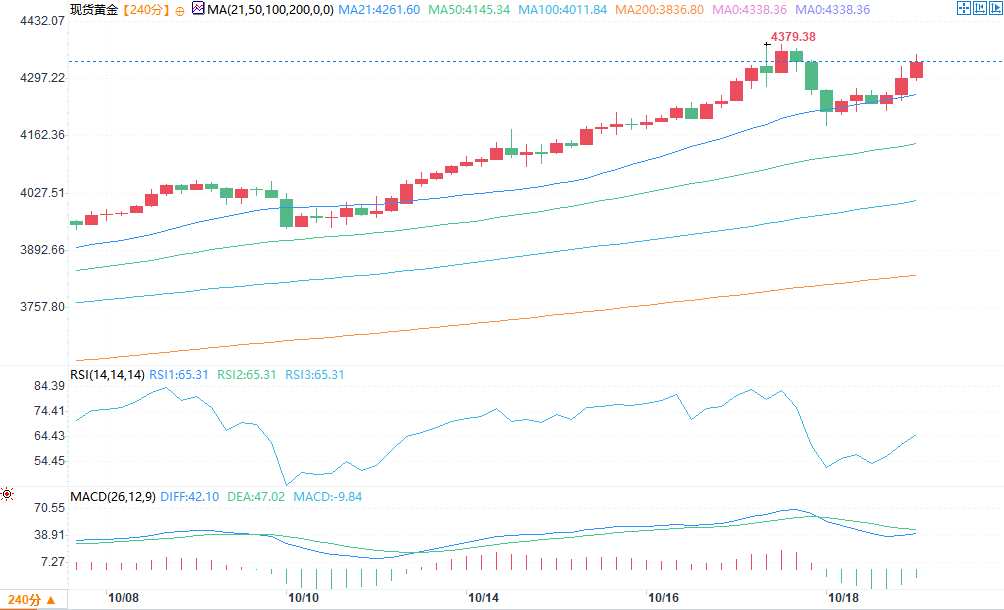Gold prices rebounded to near all-time highs as safe-haven demand grew
2025-10-21 01:45:23

Last Friday, gold experienced its biggest one-day drop since mid-May, falling 1.76%. Investors took profits after US President Trump delivered relatively dovish remarks on Sino-US relations. Trump said, "Everything will go well with China," adding that his previous threat to impose 100% tariffs on Chinese imports was "unsustainable." This statement eased market tensions, driving a rebound in the US dollar and US Treasury yields.
While the easing of trade tensions has provided a short-term respite, traders remain cautious. Trump's erratic rhetoric on trade continues to fuel global uncertainty. The lack of follow-through selling on Monday suggests that gold's pullback is more of a corrective pause than the beginning of a deeper reversal. Investors are currently reassessing the overall macro backdrop.
Gold prices continue to find support from the Federal Reserve's dovish outlook, the prolonged U.S. government shutdown, and ongoing geopolitical and economic uncertainty. These factors, combined with steady central bank demand and strong inflows into gold-backed exchange-traded funds (ETFs), have sustained gold's overall upward trend.
Market drivers: The government shutdown continues, with the market focused on US-China negotiations and CPI data.
U.S. Treasury Secretary Jeff Besant and Chinese Vice Premier He Lifeng will meet in Malaysia this week to restart talks after trade frictions escalated last week.
Multinational companies estimate U.S. tariffs have already cost them more than $35 billion. A Reuters analysis of hundreds of company statements, regulatory filings and earnings calls between July 16 and September 30 showed they expect a combined financial loss of $21 billion to $22.9 billion in 2025 and nearly $15 billion in 2026.
Clashes erupted again in the Gaza Strip early Monday morning after Israel launched airstrikes against Hamas over an alleged overnight ceasefire violation, ending a brief lull and reigniting concerns about a wider conflict in the region.
The current US government shutdown has entered its 20th day, with no resolution yet. The Senate has repeatedly tried to pass a stopgap funding bill, but each attempt has failed. The latest attempt marks the tenth attempt to break the deadlock. Once the Senate reconvenes, lawmakers are expected to vote again on Monday.
This week will be light on US economic data releases, with market focus focused on Friday's Consumer Price Index (CPI) report, which was previously delayed due to the government shutdown. Friday will also see the release of the preliminary S&P Global Purchasing Managers' Index (PMI) for October. Federal Reserve officials are currently in a pre-meeting blackout period ahead of the Federal Open Market Committee (FOMC) meeting on October 29-30.
Technical analysis: Buying interest picks up, spot gold stabilizes above $4,250
Spot gold has stabilized after a sharp pullback from its all-time high last Friday, suggesting a possible short-term peak near its all-time high of around $4,380. The 4-hour chart shows that spot gold prices are hovering above the 21-day simple moving average (SMA) at $421.

(Source of spot gold 4-hour chart: Yihuitong)
Near-term support is seen around $4,200, where bargain hunting continues. A sustained break below this level could lead to a test of the 50-period Simple Moving Average (SMA) support around $4,140. On the upside, $4,300 has previously served as near-term resistance, and a break above this level could lead to a retest of the all-time high of $4,379.38.
The Relative Strength Index (RSI) is currently holding around 63, recovering after retreating from overbought territory. As long as the RSI remains above 50, the current trend is more like a healthy consolidation phase than a deep correction, and the overall bullish trend of gold will be maintained.
- Risk Warning and Disclaimer
- The market involves risk, and trading may not be suitable for all investors. This article is for reference only and does not constitute personal investment advice, nor does it take into account certain users’ specific investment objectives, financial situation, or other needs. Any investment decisions made based on this information are at your own risk.





















